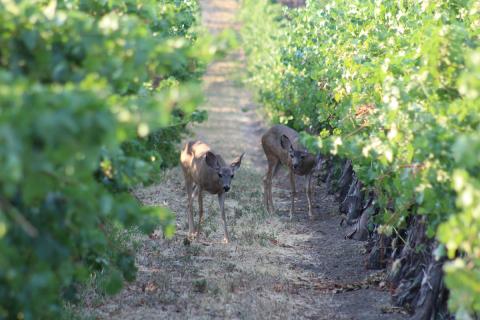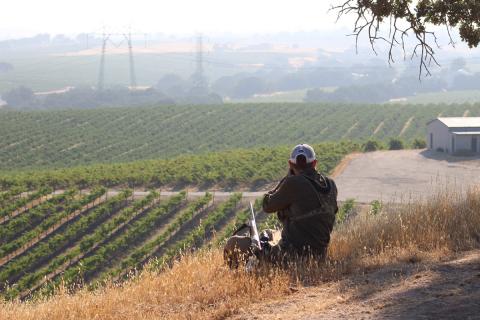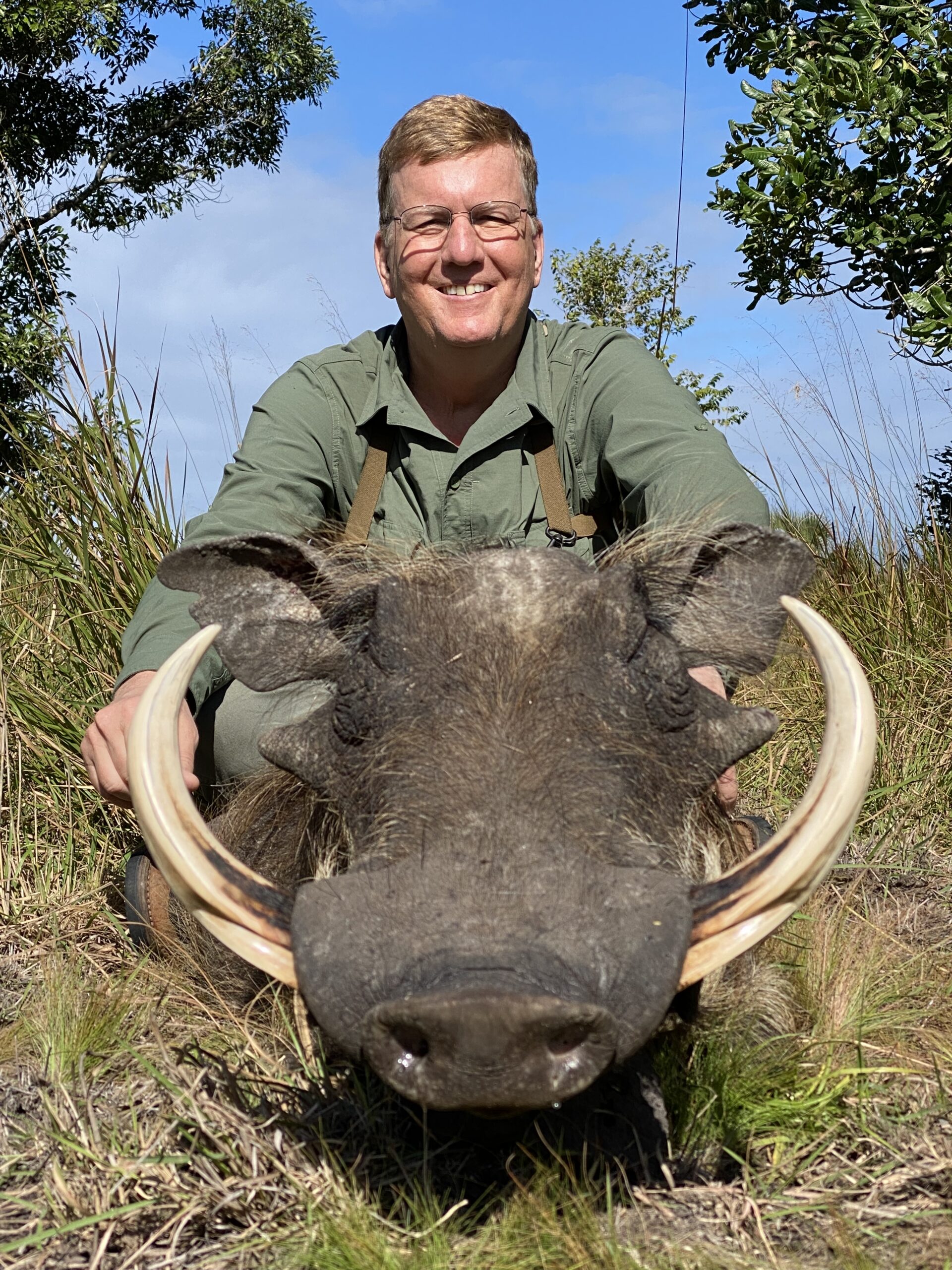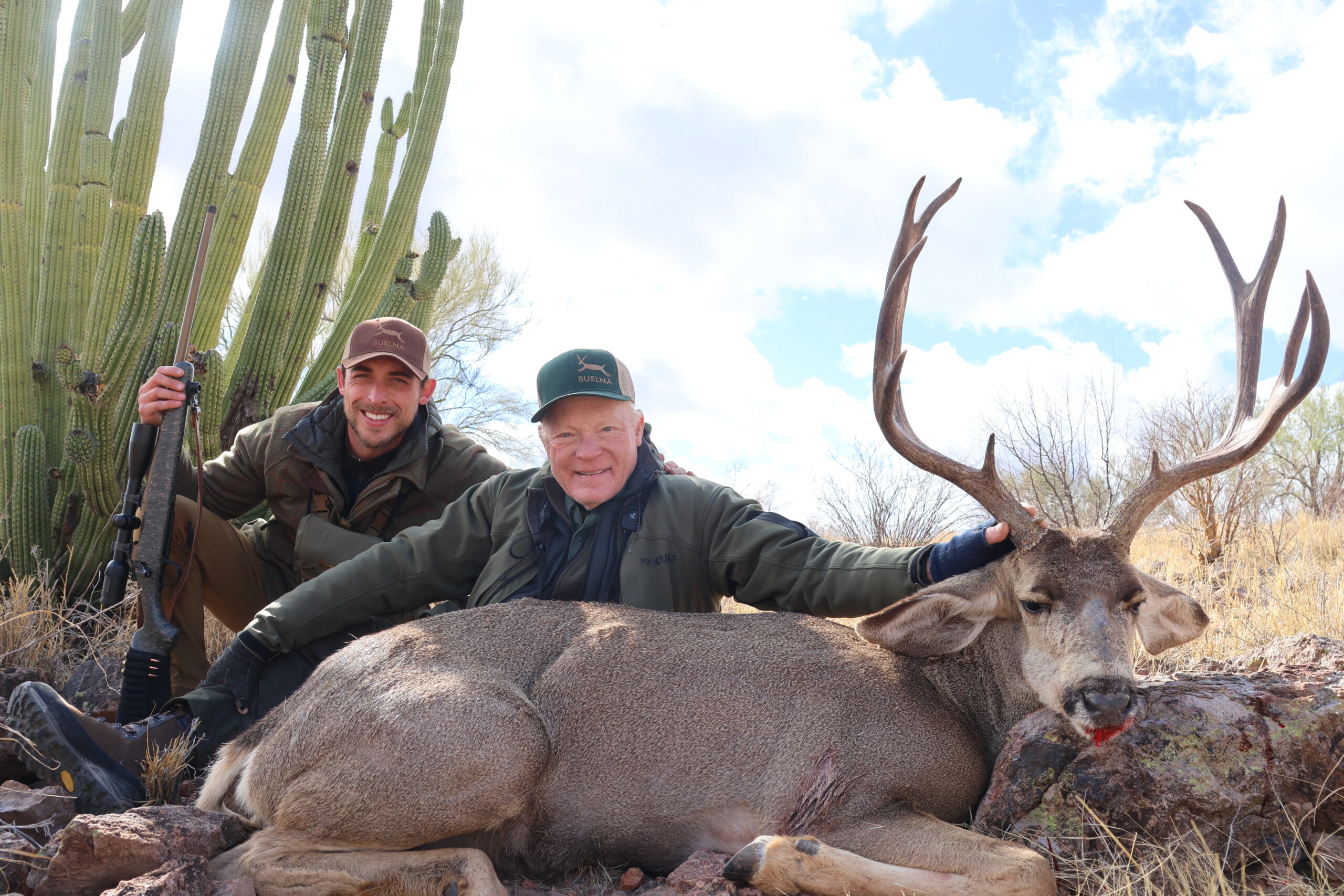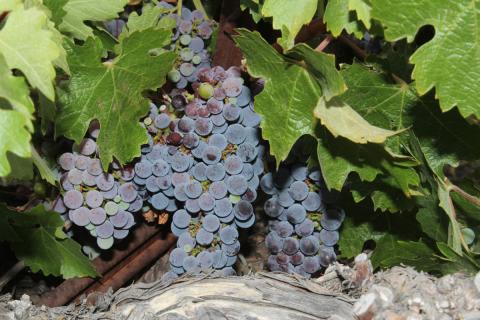
At Steinbeck Vineyards the deer get their share…
The area we residents call Central Coast runs along the low coastal mountains from below the Monterey Peninsula south toward Santa Barbara. In stairstep fashion along Highway 101 the major towns are San Luis Obispo, Atascadero, and our Paso Robles, the latter two with town squares seeming straight out of the Midwest, not cosmopolitan California. I first started hunting along the Central Coast when I was stationed at Camp Pendleton in the 70s and the area has been home for the past 25 years.
I’ve seen it change. Vineyards have long graced the area, but through the 1970s cattle ranching was king. Today the Central Coast is a major wine-producing region. There are, literally, hundreds of labels…and they produce great wines. The rolling vineyards are gorgeous, but, from a hunter’s standpoint, behind the vibrant green façade they are sterile.
The wine isn’t what brought me to the Central Coast! It was here that some enterprising ranchers got the crazy idea that city-bound hunters in L.A. and San Francisco might pay to hunt feral hogs. With periodic drought pig populations fluctuate, but the Central Coast is still home to a mini-industry based on our wild hogs, with a number of local outfitters and meat processors. Regrettably there isn’t much up and down with our deer herd. In the 70s the area was a deer factory; back in the day, we expected to take venison home from a weekend getaway. Today the deer herd is seriously depressed, although tule elk have made a dramatic comeback. Periodic drought is also a factor with our deer, but so is excess of predators, coyotes and our long-protected and plentiful cougars. Honestly, however, I place much blame on the vineyards. Most are high-fenced, blocking traditional movement corridors, and because the wine industry has such economic clout depredation permits are a standard answer. Most vintners talk a good game and their vineyards are gorgeous…but actually share their grapes with the deer?
One family that does is Steinbeck Vineyards, just east of Paso Robles. Some of their acreage has been in the family—and in grapes—since the 1880s. A hunting family, they avoid deer-proof fencing and carefully manage a resident deer herd within their vines. Although the deer can—and do—come and go, Steinbeck’s Ryan Newkirk (his mom is Cindy Steinbeck) figures they have about a hundred resident deer on their “home place.” They harvest about a half-dozen mature bucks that are exceptional for the area…plus a couple of older “management bucks.” There is little public land and islands of habitat where deer are tolerated are scarce. You bet these bucks have value, but it’s not exactly a profitable deal. Ryan figures between actual consumption and damage to infrastructure his deer may cost the family business as much as 80k a year…but the Steinbeck family have no plans to eradicate them, which, regrettably, is the route taken by most vintners.
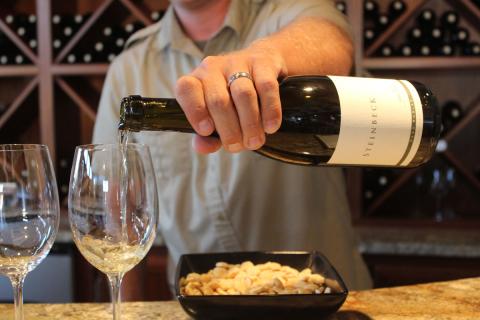
HANDING OFF THE TORCH
Ryan, his mom and grand-parents are friends. We belong to their wine club and for the last few seasons Donna and I have gone scouting with Ryan before the August season. We’ve seen some awesome bucks tucked in among the mature vines, but I’d never hunted there and although Steinbeck is only 15 minutes from home I wasn’t sure I ever would. For several years Weatherby Inc., long in Paso Robles, had all the Steinbeck deer sewed up tight. Knowing things can change, I kept telling Ryan to call me if they did. Early in 2018 Weatherby announced they were relocating to Wyoming. Things changed and true to his word, Ryan called me!
Donna and I recognized a unique situation and an exceptional opportunity to take unusually good coastal blacktails. However, this caused a bit of a dilemma: We didn’t need six bucks. These are my backyard deer; I don’t hunt them every year, but I’ve hunted them a lot, a few good ones (and some not so good). This was too good of an opportunity to pass, so I called Mossberg’s Linda Powell and Riton optics’ Brady Speth; in a few days we had a group together.
COASTAL BUCKS
Our Central Coast deer are typically small in body and antler. A “legal buck” must have a fork in the upper portion of one antler and, honestly, pickings are slim enough that around here any legal buck is considered a pretty good deer! We see the occasional three-by-three but clean four-by-fours are very rare. Regardless of points, antler spread in the upper teens is considered wide; into the twenties spectacular. I attribute the small size to summers that are long, hot and very dry, even in good rainfall years. These deer are naturally, one of California’s several mule deer subspecies. The Golden State is the only state in the Lower 48 that has no whitetails, but she has at least four races of mule deer: Columbian blacktail in the northwest, Rocky Mountain mule deer in the northeast, California mule deer in the central valleys, southern mule deer from Orange County to Baja…and just possibly desert mule deer in the harsh desert mountains in the southeast corner.
SCI accepts our Central Coast deer as Columbian blacktails. Many years ago, I had a small hand in this when I was the North American chair for our records committee and I still think Columbian blacktail is the proper classification. To the west of the stubby coastal mountains our deer bump up against California mule deer, but along the coast through Santa Barbara County at least to Ventura, “blacktail tendencies” are most common: Smaller deer, with smaller ears and typically, a full black tail stripe. The classic blacktail double white throat patch, never consistent, is often seen on our coastal deer. Antlers are as blacktails should be, sort of miniature mule deer…but it’s a rare buck that gives a big Oregon or northern California buck a run for its money. Local hunters refer to our deer as “Pacific bucks” or “Pacific coastal blacktails.” For sure they never get big enough to compete with mule deer! Nobody argues that they should be considered a separate subspecies, so Columbian blacktail is the most logical classification. In that category few of our bucks grow large enough to compete in the records. However, as I would soon learn, food and water and management make a difference.
AUGUST SEASON
California’s coastal or “A-Zone” rifle season traditionally opens the second Saturday in August, the earliest firearms season in the Lower 48. For those who like “early,” bow season opens in mid-July! It’s been that way for generations so the “why” seems lost in the sands of time. These deer probably have the earliest rut in North America; they’ll be hard into it by mid-September. The prevailing theory is the rut must be early so fawns can be born in the soft spring, before the summer stress.
Like many American deer seasons the original intent was probably for a pre-rut hunt, when the bucks are less vulnerable. However, the coastal season runs six weeks, so the tail end is almost certain to catch the first part of the rut. The local insider secret is the latter part of the season is often the best, when unknown bucks start to show up—but that skips the traditional excitement of Opening Day! August days are usually hot, but even in summer the Central Coast has one of North America’s most radical temperature swings: Between dawn and noon a 40-degree shift is normal and 50 degrees not unusual.
It’s a short hunting day, a few hours in the morning when a jacket feels good—even in August—but by mid-morning it’s hot and the deer are bedded tight and seeking shade. The evening hunt is shorter, just the last couple of hours. Even so, I reckon the evenings are usually the most productive, especially that golden hour before sunset. In mid-August the bucks are a mix. Antlers are fully formed, but some bucks are in full velvet, while others are completely stripped and polished. Some bucks will still be in small bachelor groups, while others show typical pre-rut behavior. With long summer daylight nights are short and mornings come early. Our Central Coast has become a major tourism area, so there’s a lot of local sightseeing, but plan on some productive napping between morning and evening hunts!
THE STEINBECK EXPERIENCE
“Deer camp” is a well-appointed farm house in the middle of the vineyards, available for weekend and vacation rental except during deer season. With long days and short nights some meals were done in camp, others at the Steinbeck headquarters and tasting room, close by on the property. One constant: Great Steinbeck wines as accompaniment! And a Steinbeck tradition: When a buck is harvested a bottle from the specific vines where that buck was taken is uncorked at the game pole!
With folks coming in from all over the place we concentrated on the first few days of the season in sort of staggered array. Initially our group was Linda Powell and Brady Speth, plus Donna and me, Linda from North Carolina and Brady from Arizona. Later in the week outdoor writer colleagues Andrew McKean and Bryce Towsley came in…respectively from Montana and Vermont. Brady had business elsewhere, so Riton’s Calley Carpenter came in for the last few days of our hunt. We all used Mossberg’s accurate Patriot bolt action, all in 6.5mm Creedmoor except Linda Powell used a Patriot in .308 Winchester. Donna and I shared a stainless and synthetic 6.5mm Creedmoor; all rifles were topped with Riton 4-16x50mm scopes, glassing done with Riton 10x40mm binoculars.
“Camp” was comfortable and spacious but, truly a blessing at the beginning of a hectic fall schedule, Donna and I “commuted” from our house 15 minutes away! Except for us, this was a first Central Coast experience and a first blacktail hunt for everyone…and all vowed it wouldn’t be the last!
AMONG THE VINES
Ryan has hunted deer on the Steinbeck property his whole life…and his grandfather, Howie Steinbeck, has hunted these deer a lot longer. There’s really only one possible methodology: You have to find the buck you seek standing in one of the thousands of rows of vines. The property has tall hills that allow glassing some sections of vines at distance, a half-mile and more. The deer move around and don’t seem to have strong preferences for one varietal over another. So, ultimately, the only way to find them is to look.
Uh, yeah, that sounds pretty simple but it isn’t quite as simple as it sounds. The best way to look is to cruise or walk slowly, looking down each row. Depending on temperature and shadows, you will catch deer in the clear lanes between the vines…but it isn’t quite that easy because deer also bed tightly against the trunks and are extremely difficult to see. Even when standing in the lanes, the tops of the vines reach out and create a canopy, so these vineyard deer are hard to see. After a while you get the hang of it, a dark lump or a different texture. The vineyards roll, so there are innumerable hidden folds that can’t be seen into from any angle unless you walk into them. It’s sort of a process of elimination. By hunting slowly, row to row and fold to fold, you will see deer. Somewhere, among the 600-plus acres of rows and lanes, you will see the kind of buck you’re looking for. Once a suitable buck is spotted it’s a matter of careful stalking, whether between the rows or through them, depending on where the deer is.
It can seem so easy…or not so easy. Donna came up with first shot and opening morning wasn’t far along when we saw a beautiful heavy-antlered three-by-three with polished antlers. I kept my mouth shut, not my deer, but this was a no-brainer of a Central Coast buck! It didn’t matter; Ryan and Donna began a stalk, but the buck was too close to the edge and immediately spooked. Despite intertangled vines high and irrigation tubing low these deer know their vineyards, and are able to cross rows at a dead run without visible disturbance!
That buck was gone, but just a few minutes later we saw a heavy-framed velvet buck that looked even bigger. He was standing 200 yards down a lane, offering a good opportunity for a stalk. So, Donna and Ryan unlimbered, she with the Mossberg 6.5mm Creedmoor, Ryan with our favorite African Sporting Creations shooting sticks. They moved carefully along the rows; in just a couple of minutes Ryan set up the sticks, Donna took her shot, and we all heard the bullet impact. This was not Donna’s first blacktail, but it was her first local Central Coast buck…a great beginning, and maybe not a bad ending! Her buck, with hard antlers under full velvet, was that rarity, a wide, heavy, absolutely perfect four-by-four, very much as good as it gets.
JUST KEEP LOOKING!
Linda’s buck took a bit more time. Several stalks didn’t work out, no shots fired, but a couple days later we saw two bucks drifting between the rows. Grabbing sticks and rifle, she and Ryan took off, moving slowly from row to row, then were swallowed in the maze of vines. I was just thinking that this was another dry run when Linda’s .308 barked. Her buck had amazing mass for a Central Coast deer, heavy and completely polished antlers, not a trace of velvet remaining.
And so the week went! I was actually the biggest problem; I had insisted on taking a “management buck.” Ryan spends a lot of time in the vineyard and has a pretty good idea of his “inventory” before the season. Typically, he has a lot of young bucks and a dozen or so “shooters,” but older non-trophy “management bucks” are scarce. The one I was hoping for was a weird, ancient buck with short, heavy misshapen antlers. Darned if I didn’t miss him, shot right over him, the only missed shot for the week! Howie Steinbeck got him a few days after our hunt; I wound up with a grownup three-by-two on the evening of the sixth day.
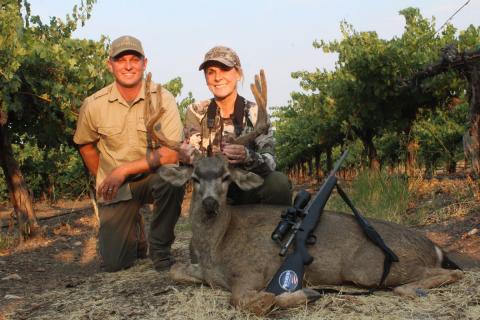
While looking—endlessly—for that weird old buck we saw some dandies, including two really big bucks that were hanging out, not just together but in a particular area. We were sort of hoping one would be for Andrew, the other for Bryce…but that didn’t quite work out. Bryce got first shot; he got one of those two bucks, a wide, heavy, spectacular four-by-three, taken in its bed at close range. The buck he’d been running with must have gotten the word; we never saw it again, but Andrew finished with a nice buck on his last evening.
I have consistently described our Central Coast blacktails as small deer. They usually are, but with soft living and year-around food and water these Steinbeck deer were anything but “small.” Dressed weights ran 180 pounds and more, a third larger in body than most of our local deer. Their venison is amazing; living in the vineyards, I call them pre-marinated, a perfect match for a good Steinbeck Cabernet!–Craig Boddington

